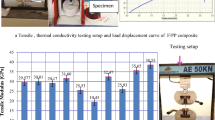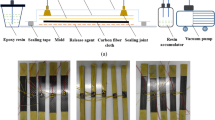Abstract
In this study, the design optimization process of a vehicle front body structure made of short-fiber composites is proposed. The aim of the optimization process is to reduce the weight in consideration of quality and production characteristics. Injection molding of short-fiber-reinforced composites leads to anisotropic material properties which depend on the dimensions of the structure, a finding which is taken into account in this research. First, a basic design is derived through topology optimization that assumes linear isotropic material properties. Second, anisotropic properties are derived by an injection molding analysis for each design point and are applied to a structural analysis to consider the anisotropic properties according to the dimensions of the structure. Third, based on the analysis results, a surrogate model is created and multi-objective optimization is conducted. The Pareto region, inversely correlated with the lightweight effect, the quality and the production characteristics, is identified. The optimal solution based on the design goal is derived using the goal-programing method.

















Similar content being viewed by others
References
Advani SG, Tucker III CL (1987) The use of tensors to describe and predict fiber orientation in short fiber composites. J Rheol 31(8):751–784
Arlot S, Celisse A (2010) A survey of cross-validation procedures for model selection. Stat Surv 4:40–79
Bendsøe MP, Kikuchi N (1988) Generating optimal topologies in structural design using a homogenization method. Comput Methods Appl Mech Eng 71(2):197–224
Boggs PT, Jon WT (1995) Sequential quadratic programming. Acta Numer 4:1–51
Brooker A, Walrd J, Wang L (2013) Lightweighting impacts on fuel economy, cost and component losses (No. 2013-01-0381). SAE Technical Paper
Cacéres C (2009) Transient environmental effects of light ally substitutions in transport vehicles. Mater Des 30(8):2813–2822
Cheron H, Moulin JP, Orlando M (1999) Modular systems: a new architecture for the front of the car (No 1999-01-0844). SAE Technical Paper
Cottrell PE (2001) Analysis of different closeout structures for a FEM (No 2001-01-0760). SAE Technical Paper
Deaton JD, Grandhi RV (2014) A survey of structural and multidisciplinary continuum topology optimization: post 2000. Struct Multidisc Optim 49(1):1–38
Fang J, Gao Y, Sun G, Zhangy Y, Li Q (2014) Crashworthiness design of foam-filled bitubal structures with uncertainty. Int J Non Linear Mech 67:120–132
Fang J, Gao Y, Sun G, Xu C, Li Q (2016) Multiobjective sequential optimization for a vehical door using hybrid materials tailo-welded structure. Proc Inst Mech Eng C J Mech Eng Sci 230(17):3092–3100
Folgar F, Tucker IIICL (1984) Orientation behavior of fibers in concentrated suspensions. J Reinf Plast Compos 3(2):98–119
Foss PH, Tseng HC, Snawerdt J, Chang YJ, Yang WH, Hsu CH (2014) Prediction of fiber orientation distribution in injection molded parts using Moldex3D simulation. Polym Compos 35(4):671–680
Gupta M, Wang KK (1993) Fiber orientation and mechanical properties of short-fiber-reinforced injection-molded composites: simulated and experimental results. Polym Compos 14(5):367–382
Hayter A (2012) Probability and statics for engineers and scientists, Nelson Education
Jeffery GB (1922) The motion of ellipsoidal particles immersed in a viscous fluid. Proceedings of the Royal Society of London A: Mathematical, Physical and Engineering Sciences 102(715):161–179. The Royal Society
Jin R, Chen W, Simpson TW (2001) Comparative studies of metamodeling techniques under multiple modelling criteria. Struct Multidiscip Optim 23(1):1–13
Kulekei M (2008) Magnesium and its alloys applications in automotive industry. Int J Adv Manuf Technol 39 (9-10):851–865
Lasdon LS, Fox RL, Ratner MW (1974) Nonlinear optimization using the generalized reduced gradient method. Revue franc̣aise d’automatique, d’informatique et de recherche opérationnelle. Recherche Opérationnelle 8(3):73–103
Laumanns M, Thiele L, Zitzler E (2006) An efficient, adaptive parameter variation scheme for metaheuristics based on the epsilon-constraint method. Eur J Oper Res 169(3):932–942
Li C, Kim IY, Jeswiet J (2015) Conceptual and detailed design of an automotive engine cradle by using topology, shape, and size optimization. Struct Multidisc Optim 51(2):547–564
Lin B, Jin X, Zheng R, Costa FS, Fan Z (2004) 3D fiber orientation simulation for plastic injection molding. AIP Conf Proc 712(1):282–287
Lucintel (2015) Growth opportunities in the global automotive lightweight materials market
Refaeilzadeh P, Tang L, Liu H (2009) Cross-validation. In: Encyclopedia of database systems. Springer, USA, pp 532–538
Rao SS (2009) Engineering optimization: theory and practice. Wiley
Seo YD, Youn SK, Yeon JH, Chang S, Yoo J (2004) Topology optimization of inner-wall stiffener for critical buckling loads of cylindrical containers. In: Multidisciplinary analysis and optimization conference, vol 30
Shenqing W, Jun L (2010) Application of ceramic short fiber reinforced Al alloy matrix composite on piston for internal combustion engines. Chinal foundry 7(4):408–411
Song X, Sun G, LI G, Gao W, Li Q (2013) Crashworthiness optimization of foam-filled tapered thin-walled structure using multiple surrogate models. Struct Multidisc Optim 47(2):221– 231
Sun G, Zhang H, Fang J, Li G, Li Q (2017a) Multi-objective and multi-case reliability-based design optimization for tailor rolled blank (TRB) structures. Struct Multidisc Optim 55(5):1899–1916
Sun G, Zhang H, Lu G, Jianwen Guo, Cui J, Li Q (2017b) An experimental and numerical study on quasi-static and dynamic crashing behaviors for tailor rolled blank (TRB) structures. Mater Des 118:175–197
Sun G, Liu T, Fang J, Steven GP, Li Q (2018) Configurational optimization of multi-cell topologies for multiple oblique loads. Struct Multidisc Optim 57(2):469–188
VerWeyst BE, Tucker III CL, Foss PH, O’Gara JF (1999) Fiber orientation in 3-D injection molded features: prediction and experiment. Int Polym Process 14(4):409–420
Wang GG, Shan S (2007) Review of metamodeling techniques in support of engineering design optimization. J Mech Des 129(4):370–380
Xiong F, Wang D, Ma Z, Chen S, Lv T, Lu F (2018) Structure-material integrated multi-objective lightweight design of the front end structure of automobile body. Struct Multidisc Optim 57(2):829–847
Zhang H, Sun G, Xiao Z, Li G, Li Q (2018) Bending characteristics of top-hat structures through tailor rolled blank (TRB) process. Thin-Walled Struct 123:420–440
Zheng G, Pang T, Sun G, Suzhen Wu, Li Q (2016) Theoretical, numerical, and experimental study on laterally variable thickness (LVT) multi-cell tubes for crashworthiness. Int J Mech Sci 118:283–297
Zhu G, Sun G, Li G, Cheng A, Li Q (2018) Modeling for CFRP structures subjected to quasi-static crushing. Compos Struct 184: 41–55
Author information
Authors and Affiliations
Corresponding author
Additional information
Publisher’s Note
Springer Nature remains neutral with regard to jurisdictional claims in published maps and institutional affiliations.
Rights and permissions
About this article
Cite this article
Park, SW., Choi, JH. & Lee, BC. Multi-objective optimization of an automotive body component with fiber-reinforced composites. Struct Multidisc Optim 58, 2203–2217 (2018). https://doi.org/10.1007/s00158-018-2008-1
Received:
Revised:
Accepted:
Published:
Issue Date:
DOI: https://doi.org/10.1007/s00158-018-2008-1




